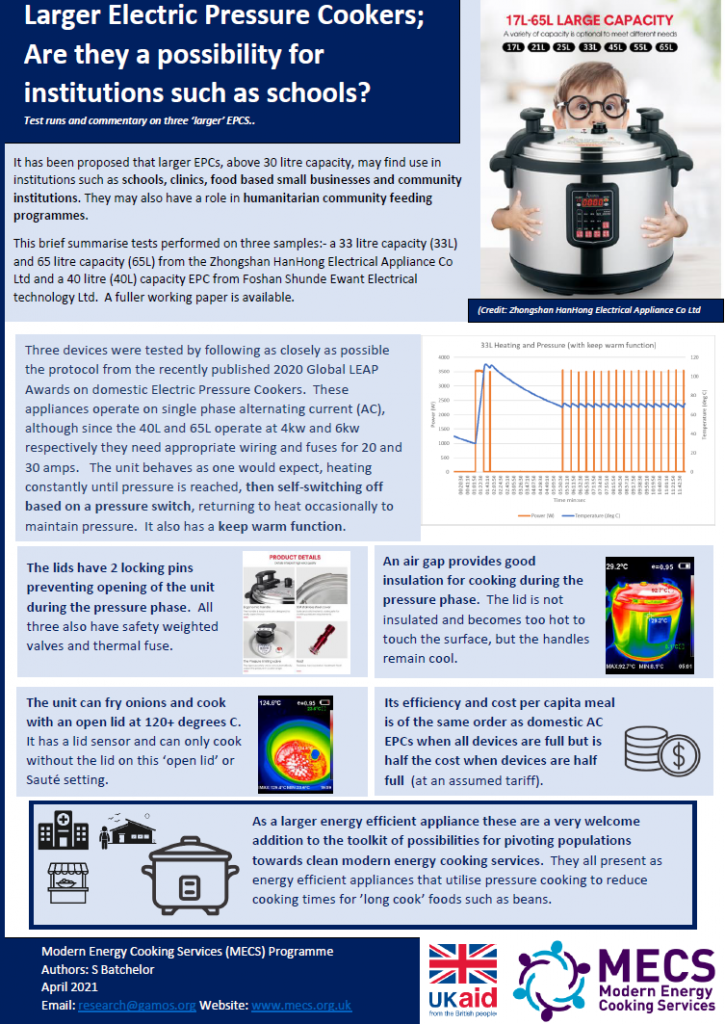
- Date
- 28th June 2021
- Categories
By Dr. Simon Batchelor (Gamos Ltd.)
Readers of our blogs will note that we mainly talk about domestic cooking, and how to pivot those using biomass to cook with at home, to a modern energy cooking solution. However, there is also the challenge of institutions. A recent landscape document on the institutional challenges pointed to the possibilities for institutional modern energy cooking services.
As a part of this, we have begun to explore larger electric pressure cookers – that might cater for schools or canteens. In a new working paper, I present the results of testing three ‘larger’ electric pressure cookers are assessed for potential use in institutions such as schools.
The test samples were advertised as 33 litre capacity (33L) and 65 litre capacity (65L) both from the Zhongshan HanHong Electrical Appliance Co Ltd company in China, and a 40 litre (40L) capacity EPC from Foshan Shunde Ewant Electrical technology Ltd company also in China. These are by no means the only devices on the market, and their choice was arbitrary and based on convenience (responsiveness on Alibaba!).
The three devices were tested following as closely as possible the protocol from the recently published 2020 Global LEAP Awards Electric Pressure Cooker Competition. The Global Leap protocol, which resulted in the Global Leap Buyer’s Guide, was designed for domestic EPCs, but nevertheless most tests were possible on the larger systems.
The stated capacities of the appliances are exaggerated, and each one can only take practically 90% of their stated capacity. This is acknowledged by the manufacturer since the ‘FULL’ mark (for non-frothing liquid food) is below the lip of the pan. However since the protocol measures the performance by half filling the pot this was not an issue.
In brief all of the devices perform as expected with suitable control of the heating phase, timing of the pressure phase, and an ability to do open lid cooking. All of the devices have suitable safety features including 2 locking pins for the lid. They present as quality appliances that have appropriate outer casing, lids, handles, pots, etc and are resistant to tilting.
Two weaknesses were noted by the author:- the lids are not insulated and do not have an intermediary disc as sometimes found in better quality domestic EPCs, and the non stick surface came off the 33litre. A lid disc can prevent splashed food or frothing from stopping the locking pins from sealing, although the pins and weighted safety valve are protected by a small cover.
The paper also presents a comparison of whether multiple smaller devices use an equivalent energy as the one larger device. There is debate among the MECS partners as to whether chefs could be organised to run multiple smaller devices staggering the food delivery, and whether this might be more convenient than these ‘larger’ EPCs. Note, the 65L weighs 30kg + even when empty and a full pot of food cannot be easily lifted out of the unit (although of course the food could be served from the unit).
When half full (as the test protocol suggest) the energy consumption per meal (assumed to be 0.3 litres) is approximately half the per meal in multiple smaller (half filled) devices. However, when devices are filled, the energy consumption per portion is approximately the same for larger EPC and multiple smaller ones. Perhaps a core question for planning an institutional makeover of a kitchen is not so much what is the most energy efficient strategy but how much working surface there is, what do the chefs prefer, what is the quality of the power supply to the school and its local wiring and fuse boxes, and the cost of devices landed and cleared of customs.
Our colleagues in Tanzania at TaTEDO are already researching the use of one of these devices, and we look forward to getting their feedback soon.
……………………………………………….
Main image: TaTEDO have begun to explore larger EPCs. Image credit: S. Batchelor (Gamos Ltd.), 2021.
